The story of the Pilgrims’ journey 400 years ago, and the voyage of Mayflower II in 1957, are still sources of inspiration today.
-
October 2020
Volume65Issue6
Editor’s Note: We are delighted to publish another essay by Nathaniel Philbrick, author of such outstanding books as In The Heart of the Sea and Sea of Glory. Portions of this essay appeared in Mayflower: A Story of Courage, Community, and War.
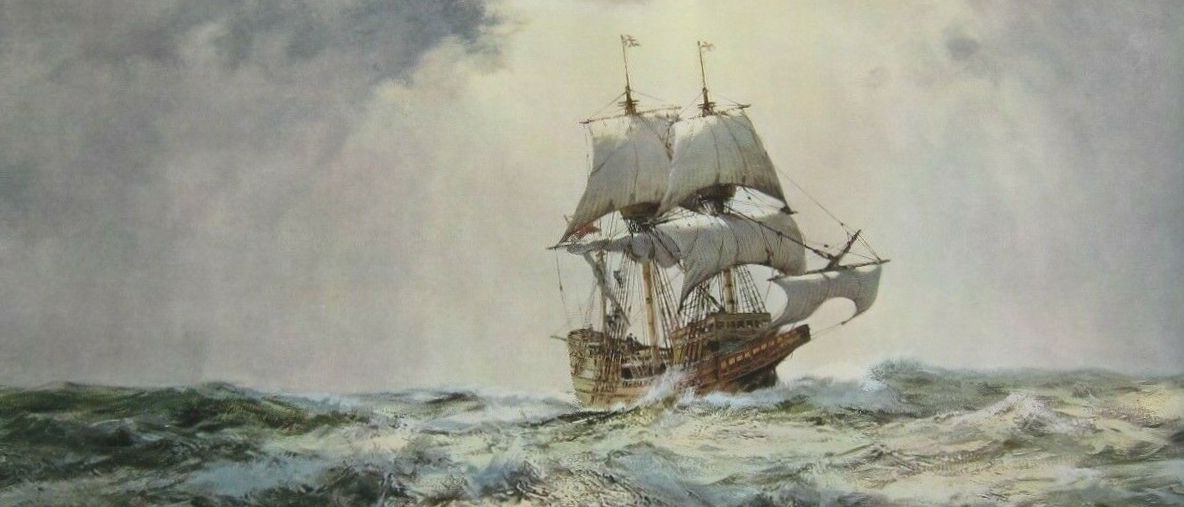
In our digital age, with jets flying overhead and giant container ships plowing across the ocean’s surface while hi-tech nuclear submarines move secretly through the watery darkness below, we tend to look at past modes of transportation, especially old wooden sailing ships, as antiquated and quaint. But nothing could be further from the truth. In her day, the Mayflower represented the culmination of centuries of technological development.
Four hundred years ago, a structure a little more than a hundred feet long built by hand of wood, iron, hemp, and flax used only the wind to transport more than a hundred people safely across three thousand miles of ocean. There was no GPS, no support network of instant communication, few maps, and just one ship in the midst of a turbulent sea, headed to a place about which her passengers knew virtually nothing.
For sixty-five days, the Mayflower had blundered her way through storms and headwinds, her bottom a shaggy pelt of seaweed and barnacles, her leaky decks spewing salt water onto her passengers’ devoted heads. There were 102 of them — 104 if you counted the two dogs: a spaniel and a giant, slobbery mastiff.
Most of their provisions and equipment were beneath them in the hold, the primary storage area of the vessel. The passengers were in the between, or ’tween, decks — a dank, airless space about seventy-five feet long and not even five feet high that separated the hold from the upper deck.
See also: Mayflower II Returns Home
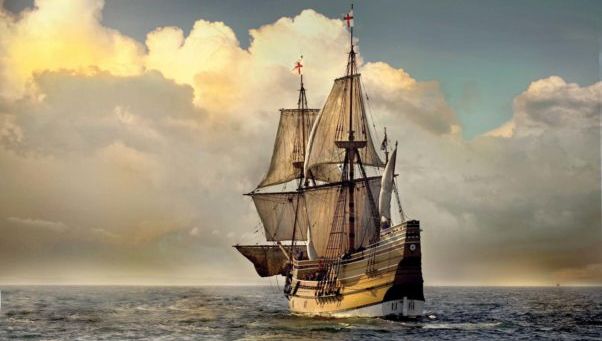
The ’tween decks was more of a crawlspace than a place to live, made even more claustrophobic by the passengers’ attempts to provide themselves with some privacy. A series of thin-walled cabins had been built, creating a crowded warren of rooms that overflowed with people and their possessions: chests of clothing, casks of food, chairs, pillows, rugs, and omnipresent chamber pots. There was even a boat — cut into pieces for later assembly — doing temporary duty as a bed.
They were nearly ten weeks into a voyage that was supposed to have been completed during the balmy days of summer. But they had started late, and it was now November, and winter was coming on. They had long since run out of firewood, and they were reaching the slimy bottoms of their water casks. Of even greater concern, they were down to their last casks of beer. Due to the notoriously bad quality of the drinking water in seventeenth-century England, beer was considered essential to a healthy diet.
And sure enough, with the rationing of their beer came the unmistakable signs of scurvy: bleeding gums, loosening teeth, and foul-smelling breath. So far only two had died — a sailor and a young servant — but if they didn’t reach land soon many more would follow. They had set sail with three pregnant mothers: Elizabeth Hopkins had given birth to a son, appropriately named Oceanus, and Susanna White and Mary Allerton were both well along in their pregnancies. It had been a miserable passage. In midocean, a fierce wave had exploded against the old ship’s topsides, straining a structural timber until it had cracked like a chicken bone.
The Mayflower’s master, Christopher Jones, had considered turning back to England. But Jones had to give his passengers their due. They knew next to nothing about the sea or the savage coast for which they were bound, but their resolve was unshakable. Despite all they had so far suffered — agonizing delays, seasickness, cold, and the scorn and ridicule of the sailors — they had done everything in their power to help the carpenter repair the fractured beam. They had brought a screw jack — a mechanical device used to lift heavy objects — to assist them in constructing houses in the New World. With the help of the screw jack, they lifted the beam into place, and once the carpenter had hammered in a post for support, the Mayflower was sound enough to continue on.
They were a most unusual group of colonists. Instead of noblemen, craftsmen, and servants — the types of people who had founded Jamestown in Virginia — these were, for the most part, families — men, women, and children who were willing to endure almost anything if it meant they could worship as they pleased. The motivating force behind the voyage had come from a congregation of approximately four hundred English Puritans living in Leiden, Holland.
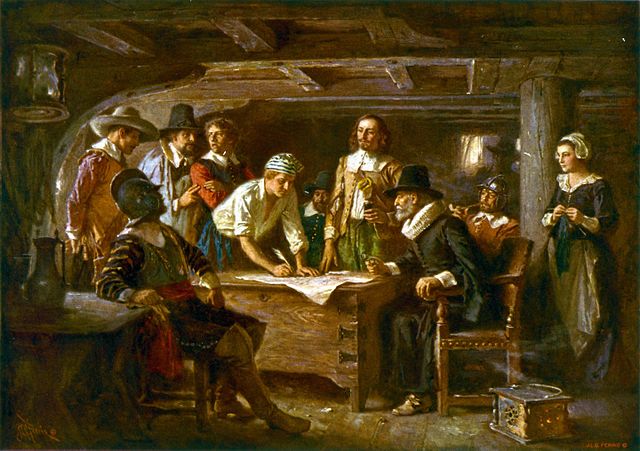
Like all Puritans, these English exiles believed that the Church of England must be purged of its many excesses and abuses. But these were Puritans with a vengeance. Instead of working for change within the established church, they had resolved to draw away from the Church of England — an illegal act in Jacobean England. Known as Separatists, they represented the radical fringe of the Puritan movement. In 1608, they had decided to do as several groups of English Separatists had done before them: emigrate to the more religiously tolerant country of Holland. They had eventually settled in Leiden, a university town that could not have been more different from the rolling, sheep-dotted fields of their native England.
Under the leadership of their charismatic minister, John Robinson, their congregation had more than tripled in size. But once again, it had become time for them to leave. As foreigners in Holland, many of them had been forced to work menial, backbreaking jobs in the cloth industry, and their health had suffered. Despite the country’s reputation for religious tolerance, a new and troubling era had come to Holland as a debate among leading theologians of the day sparked civil unrest and, on occasion, violence. And gradually their children were becoming Dutch. By sailing to the New World, they hoped to re-create the English village life they so dearly missed while remaining beyond the meddlesome reach of King James and his bishops.
It was a stunningly audacious proposition. With the exception of Jamestown, all other attempts to establish a permanent English settlement on the North American continent had so far failed. And Jamestown, founded in 1607, could hardly be counted a success. During the first year, 70 of 108 settlers had died. The following winter came the “starving time,” when 440 of 500 settlers were buried in just six months. As it turned out, the most lethal days in Jamestown were yet to come. Between 1619 and 1622, the Virginia Company would send close to 3,600 settlers to the colony; over that three-year period, 3,000 would die.
In addition to starvation and disease, there was the threat of Indian attack. At the university library in Leiden were sensational accounts left by earlier explorers and settlers, telling how the Indians “delight to torment men in the most bloody manner that may be; flaying some alive with the shells of fishes, cutting off the members and joints of others by piecemeal and broiling on the coals.” How could parents willingly subject their children to the risk of such a fate? In the end, all arguments for and against emigrating to America ended with the conviction that God wanted them to go. The world, they believed, was on the verge of the millennium — the thousand-year rule of the saints predicted in the book of Revelation. In 1618, a comet appeared in the skies over Europe, signaling, many thought, the final, apocalyptic battle of good against evil.
And, in fact, what became known as the Thirty Years’ War would rage across the Continent as Protestant and Catholic forces reduced much of Europe to a burning, corpse-strewn battleground. So far, England had avoided this conflict, and as all God-fearing English Puritans knew, their country had been earmarked by the Lord to lead his forces in triumph. Instead of Europe, perhaps America, a continent previously dominated by the Catholic powers of Spain and France, was where God intended to bring the reformed Protestant Church to perfection.
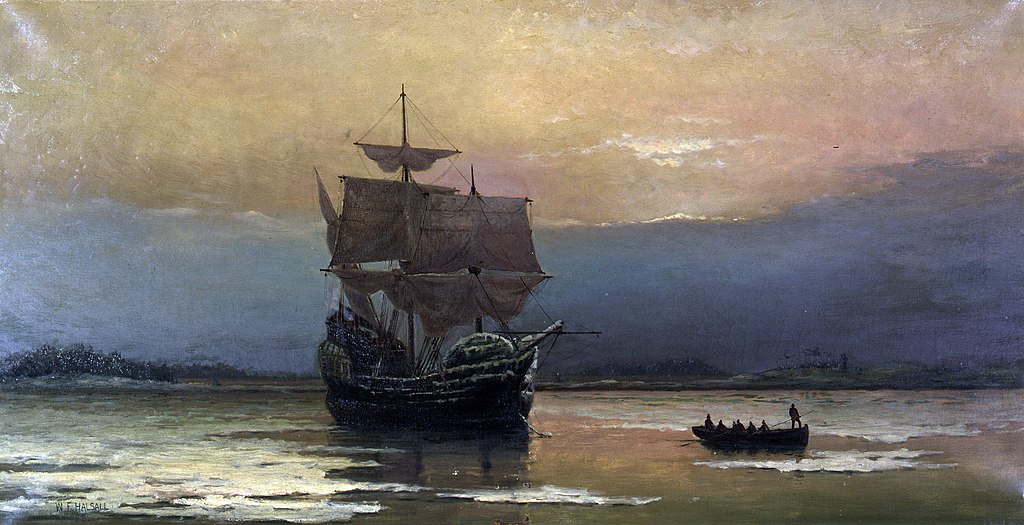
All Englishmen had heard of the atrocities the Spaniards’ hateful hunt for gold had inflicted on the Indians of America. England, it had been predicted by Richard Hakluyt, the chronicler of British exploration, would do it differently. It was the Leideners’ patriotic and spiritual duty to plant a godly English plantation in the New World. “We verily believe and trust the Lord is with us,” they wrote, “and that He will graciously prosper our endeavors according to the simplicity of our hearts therein.”
Even though many of the passengers were making the voyage for the good of their souls, controversy and dissension divided the group even before they left England. Just about everything that could go wrong, did go wrong. Delays plagued them from the start, and they ended up departing Plymouth, England, in September, meaning that when they made it across the Atlantic, they arrived on the cusp of winter — the worst possible time to start a new community.
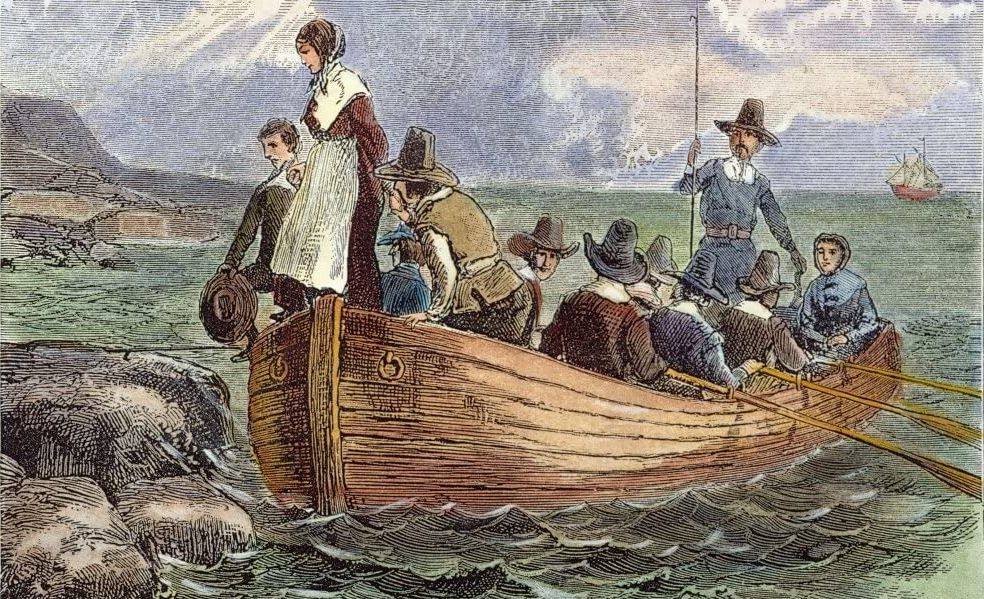
Once they decided to begin building a settlement at what they called Plimoth Plantation — on land that the local Wampanoags called Patuxet — disease killed half of them that first winter. Without the intervention of the Wampanoag sachem Massasoit, who was looking for an ally to assist his own disease-decimated people, the English settlement at Plimoth Plantation would have ceased to exist.
During that dreadful winter, Master Jones’s crew was also struck by illness, and it was not until April 1621 that he determined the surviving sailors were strong enough to attempt the return passage. Although the Mayflower made excellent time during her return to England, Jones would be dead within the year. After his burial at a graveyard beside the Thames, his ship never set sail again and at some point was broken up for scrap.
The Mayflower II
If you visit Plimoth Plantation today, you can see a modern replica of that original ship. Much more than a mere museum exhibit, the Mayflower II is an oceangoing vessel with her own story to tell. The voyages of these two ships, almost four centuries apart, are powerful proof that while many things have changed in this country and this world, the sea is still a watery wilderness that no mariner can take for granted.
In the mid-1950s, a young Englishman named Warwick Charlton read William Bradford’s Of Plimoth Plantation during a flight from Singapore. Charlton had served during World War II as an aide to Field Marshal Montgomery and had come to appreciate the vital importance of the British-American alliance. “The story [of the Pilgrims],” he wrote, “had excited my interest, but one paragraph in Bradford’s journal . . . caught my imagination: ‘May not and ought not the children of these fathers rightly say, “Our fathers were Englishmen which came over this great ocean, and were ready to perish in this wilderness.” Quite suddenly I knew what I wanted to do and what I would do. In the fashionable postwar mood of doubt and disillusionment, my plan would recall a struggle and an achievement which held a message for both peoples. . . . I would rebuild Mayflower — and she would sail to America.’” Much like the Statue of Liberty and France, Mayflower II was intended as a gift from the people of Great Britain to their counterparts in the United States.
Almost immediately, Charlton realized there was a serious problem with his plan. In almost every instance that a historic replica of a famous ship had been built, the lack of a permanent home had led to its neglect and ultimate ruin. Two reproductions of Columbus’s ships had sailed from Spain for the Chicago World’s Fair in 1893 and were now rotting on the city’s waterfront. The same had happened to a replica of Leif Erikson’s longboat.
Before Charlton started raising money to build the Mayflower II, he needed to find someone who would be willing to take her on — a not inconsiderable responsibility given the notorious expenses of maintaining a wooden ship. As luck would have it, an organization had been recently formed in Massachusetts called Plimoth Plantation and he quickly came to realize that this would be the perfect home for the Mayflower II.
Charlton found a boatyard in the tiny Devon town of Brixton to build the ship. One of the biggest oak trees in Britain — more than six feet in circumference — was felled to make the ship’s main stem. Another enormous log was needed for the 58-foot-long keel, while a 24-inch square log was shaped by hand with adzes to create the 67-foot mast. Using only traditional materials and methods, the canvas sails were made out of flax, while hemp was used for the cordage.
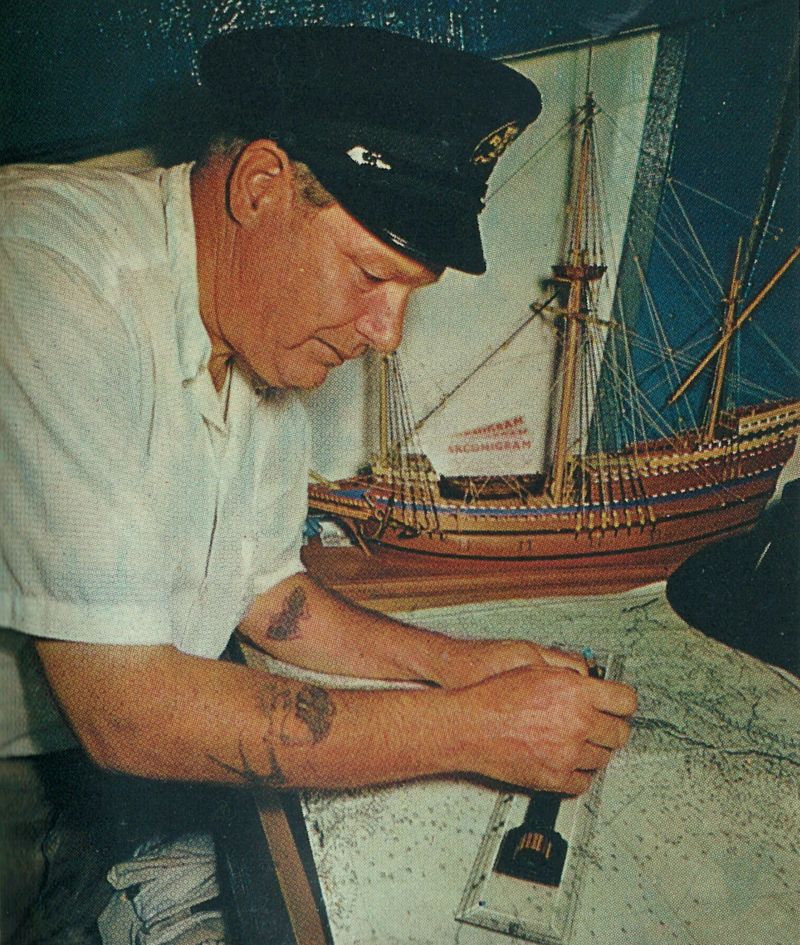
The search for a captain led Charlton to Alan Villiers, the most experienced commander of square-rigged ships in the world. In the 1930s he had saved what would become the Joseph Conrad from destruction and circumnavigated the globe in it, an adventure that bankrupted him financially but inspired several books. Since 1947 she has been moored at Mystic Seaport at an exhibit and training ship.
Villiers had also captained the ship that served as the Pequod in John Huston’s 1956 movie Moby-Dick. Not unsurprisingly, many of the officers and men from that ship found their way to the Mayflower II, an almost cosmic melding of Melville, whaling, and the Pilgrims that is most appropriate given that Mystic Seaport, where the Mayflower II underwent an extensive overhaul, is also the home of America’s only surviving nineteenth-century whaling ship, the Charles W. Morgan. Mystic and the Mayflower seemed destined for each other.
Like the first Mayflower, the Mayflower II began its voyage across the Atlantic under less than auspicious circumstances. She was launched on April 1, 1957, during a thunderstorm, and soon after hitting the water, the hull almost rolled over and capsized due to a lack of ballast. One journalist gave the Mayflower II a fifty-fifty chance of making it successfully across the Atlantic. Time constraints prevented Villiers from conducting any significant sea trials before the ship was scheduled to depart from Plymouth, England, on April 20, 1957.
Villiers soon discovered that the ship’s wobbly launch had led the builder to overcompensate with too much ballast. A hundred and thirty tons of railway iron and old furnace bars had been stacked in the hold. Not only did this sink the ship below her proper waterline, it had the effect of making her very “stiff.” Instead of gliding over the waves with an easy motion, the Mayflower II had a tendency, in Villiers’s words, to “roll violently . . . She was like a wild little bronco constantly taking an uneven series of high fences and rolling and all but falling over as she came to each one.” The motion was so severe that each night it threatened to pitch Villiers from his bunk. But it was aloft, where the masts magnified the motion of the hull, that the real danger lay, especially in foul weather.
Fearful that he might lose the rigging if he followed the original Mayflower’s northern route, where storms and icebergs were predicted, he opted for the southern route past the Canary Islands. This required him to sail more distance, but it proved a brilliant strategy as the light to moderate winds pushed the little ship along at a surprisingly good clip, sometimes as high as seven and a half knots. “Her merit was her capacity to slip along easily in quiet winds,” he wrote.
By June 8, they were 160 miles east of Nantucket, when the weather took a sudden turn for the worse. The winds climbed into the forties, and it started to rain hard. “The ship started to pitch heavily,” remembered Warwick Charlton, who served as one of the crew, “and every time she thudded into the sea the bowsprit whipped in and out like a giant fishing pole. The hum of the wind in the rigging, the pounding of the seas against the ship’s sides, the splash of rain across the decks were the voice of the gale blowing with increasing fury from the east.”
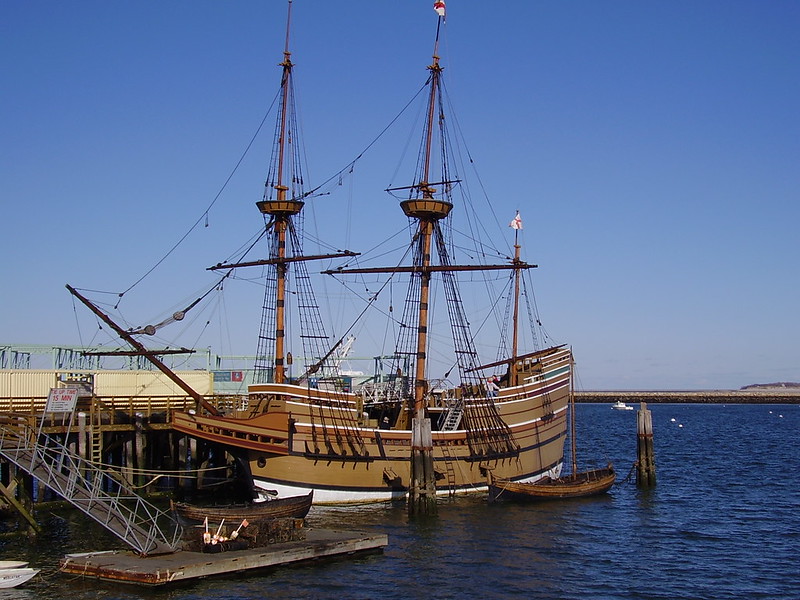
Villiers ordered all hands on deck and into life jackets; lifelines were rigged fore and aft. He then took over the wheel and began issuing orders to take in all sail. What concerned him the most was the rectangle-shaped sail at the bow. “The bowsprit was taking a terrible beating,” Chariton wrote. “The ship was first carried high on the waves and then plunged down into the depths of the green walls of water. . . The captain was calm, decisive, smiling at those near him and nodding approval when an order was carried out.” Soon all sails had been taken in and furled, and the Mayflower II was under bare poles. Now that the sails were no longer steadying the ship, Villiers needed to ease her severe motion in the storm and “lie ahull,” with the helm lashed to leeward.
On their fifty-third day, June 11, 1957, they came upon the Coast Guard training ship Eagle. She was near enough that her captain could be heard shouting, “What ship?” Villiers replied, “The Mayflower, three hundred and fifty years out from England, sir.” That afternoon they sighted the Nantucket lightship, which sounded her horn as the Mayflower II passed to starboard. Despite having sailed a greater distance, they were more than ten days ahead of the original Mayflower.
A few days later, after a night at Provincetown, the Mayflower II was escorted to Plymouth Harbor by a huge armada of vessels. A shallop built by Plimoth Plantation rowed Villiers and Charlton to Plymouth Rock, where they were greeted by Ellis Brewster, a descendant of William, and Yellow Feather, a descendant of Massasoit. The voyage, which Villiers later called “the greatest and most interesting sailing adventure of my life,” was over.
In 2007, in celebration of the fiftieth anniversary of her voyage to Plymouth, the Mayflower II set sail for the first time in a number of years. My wife, Melissa, and I were privileged to be present on that beautiful summer day just outside Plymouth Harbor when the sails were unfurled in about twelve knots of wind and the ship began to slip through the water under her own power. It was an experience I’ll never forget, especially since there were several of the ship’s original crewmembers aboard, along with the son of Alan Villiers.
Warwick Charlton assumed that once the Mayflower II was docked in Plymouth, she would never sail again. But her stewards at Plimoth Plantation, with the help of shipwrights at Mystic Seaport, have ensured that this brave little ship, which once tossed in the waves off the deadly shoals along Nantucket Island’s southern shore, will not only sail again — she will be stronger than ever, and continue to inspire and instruct for generations to come.
The Mayflower II has earned her own fame, but she is also important as a source of inspiration to those in search of new beginnings and a symbol of the possibility of multicultural cooperation in this nation of immigrants. She also speaks to the dark truths underlying the settlement of New England and America. Like a sturdy wooden time machine, she takes us back to the beginning.
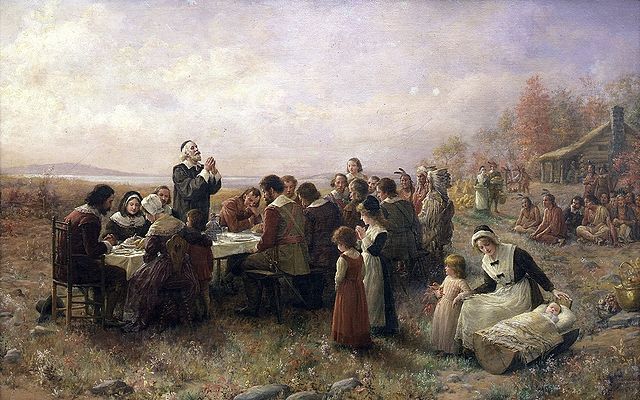
The story of the Pilgrims does not end with the First Thanksgiving. When we look to how the Pilgrims and their children maintained more than fifty years of peace with the Wampanoags and how that peace suddenly erupted into one of the deadliest wars ever fought on American soil, the history of Plymouth Colony becomes something altogether new, rich, troubling, and complex. Instead of the story we already know, it becomes the story we need to know.
In this respect, there is a surprising amount of truth in the tired, threadbare story of the First Thanksgiving, but the Indians and English of Plymouth Colony did not live in a static idyll of mutual support. Instead, it was a half century of struggle and compromise — a dynamic, often harrowing process of give and take. As long as both sides recognized that they needed each other, there was peace. The next generation, however, came to see things differently.

